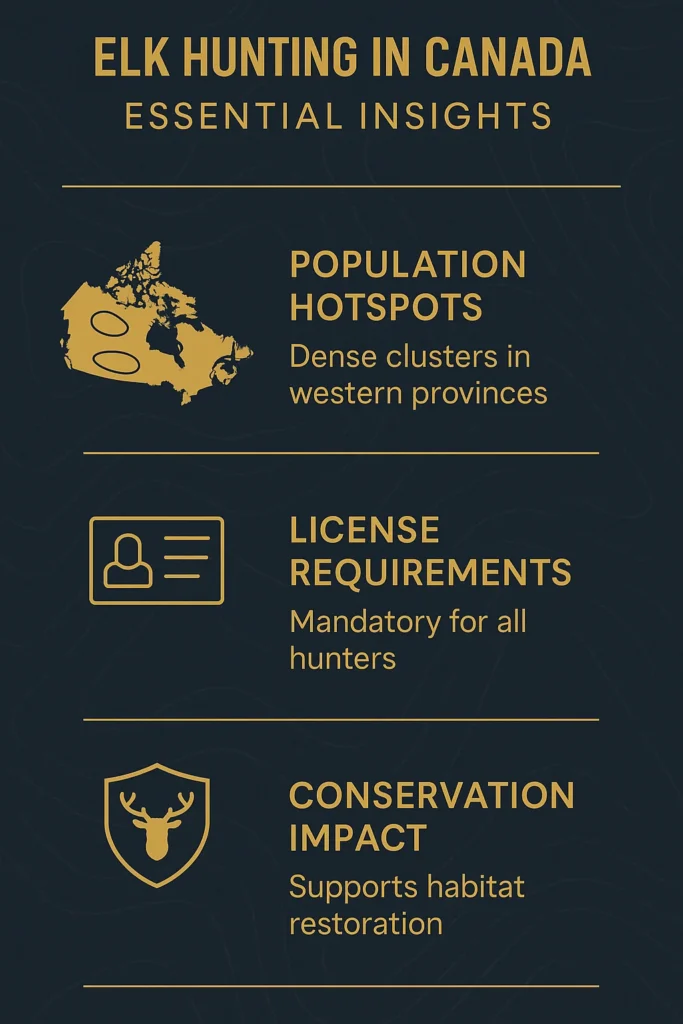Elk hunting in Canada is a popular activity. It is carefully managed by rules and seasons in different regions.
In a Nutshell: Elk Hunting
- You will learn about current elk hunting rules in Canada.
- You will understand where and how to hunt elk.
- You will find out about licenses and fees.
- You will see how to hunt elk safely and wisely.
Estimated reading time: 6 minutes
Dreaming of a Canadian elk hunt? It’s a challenging and rewarding adventure. Knowing the rules and best practices is key. This guide helps you prepare for a successful and responsible hunt.
Understanding Elk Hunting in Canada
Elk hunting in Canada is a popular outdoor activity. Hunters from all over the country enjoy it. It involves tracking and hunting elk, a large deer species. Rules for hunting change by province. You must follow these rules to hunt legally. This helps keep elk populations healthy.

Rules and Seasons by Region
Elk hunting rules vary across Canada. Each province has its own laws. You need to know these rules before you go.
- Ontario: Elk hunting here is controlled. You must apply for a special draw. The deadline for applying is usually early June, like June 10, 2025, according to the 2025 Ontario Hunting Regulations Summary. Elk are not found everywhere in Ontario. Hunting is allowed only in specific areas.
- Yukon: Rules here have changed. The Braeburn elk hunt will close for the 2025-26 season. This helps the local elk population grow stronger, as announced by the Yukon government.
- British Columbia: You can hunt elk here through Limited Entry Hunting (LEH). This system controls how many hunters can go. Group hunts are not allowed in some areas, like Regions 1 and 2, based on LEH Regulations.
Licenses and Fees for Elk Hunting
You need the right papers to hunt elk. This includes licenses and permits.
- Ontario: You must buy an Outdoors Card. Then you need a hunting license, as outlined in the Ontario Hunting Regulations Summary.
- British Columbia: Costs change based on your hunt type. They also depend on if you live in the province or not.
This widget helps you quickly check if you have the right license.
Do You Need an Elk Hunting License?
Quickly check if you need a specific license for elk hunting in Canada.
Elk Populations and Hunter Success
Elk hunting is not as common as other types of hunting. But many hunters love its challenge. They enjoy the experience it offers.
- Elk Numbers: The number of elk is different in each area. British Columbia has many elk. Ontario has fewer.
- Hunting Success: Your chances of success depend on many things. These include the hunting spot, the season, and your skill. In British Columbia, success rates for elk hunting are fair. You must apply through the LEH system.
Challenges and Help for Hunters
Keeping elk populations healthy is important. Many groups work on this. For example, the Yukon closed an elk hunt. This helps the local herd recover, as noted by the Yukon government.
Many groups also offer help for new hunters. These mentorship programs teach skills. They make the hunting experience better. You can find more about hunting in Canada.
- Know the Rules: Always check local hunting regulations before you go.
- Scout Your Area: Learn the land and elk habits before the season.
- Practice Calling: Good elk calls can bring animals closer.
- Use Good Gear: Proper hunting gear makes your trip safer and better.
- Be Patient: Elk hunting often needs a lot of quiet waiting.
Learning More About Elk Hunting
YouTube is a great place to learn about elk hunting. You can find many videos there. They offer tips on hunting strategies and gear reviews. Hunters share their own stories.
They talk about calling techniques and stalking methods. They also show how to set up successful hunts. This helps you prepare for your own trip.
You can also explore options for big game hunting lodges in Canada.
My Experience with Elk Hunting
I once spent a week in British Columbia, learning about elk behavior. It taught me the importance of patience and quiet movement. Understanding their habits, like feeding times and travel paths, made a huge difference.
Even without a successful harvest, the experience of being in their natural habitat was truly rewarding. It showed me that elk hunting is more than just the pursuit; it’s about connecting with nature.
Conclusion
Elk hunting in Canada is a rewarding journey. It demands respect for nature and its rules. Always stay updated on local laws. Hunt responsibly. This helps keep elk populations strong for the future.
Your Questions About Elk Hunting Answered (Simply)
What is the best time to hunt elk in Canada?
Do I need a guide for elk hunting in Canada?
What gear do I need for elk hunting?
How much does an elk hunting trip cost?
Are there any special rules for non-resident hunters?
Where are the best places to hunt elk in Canada?
How do conservation efforts affect elk hunting?


